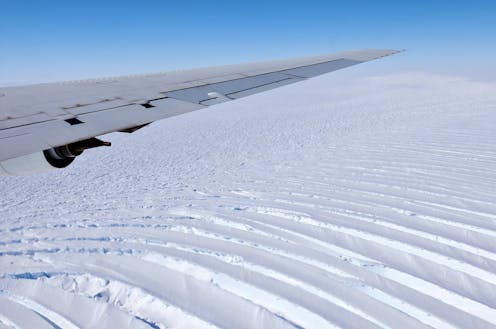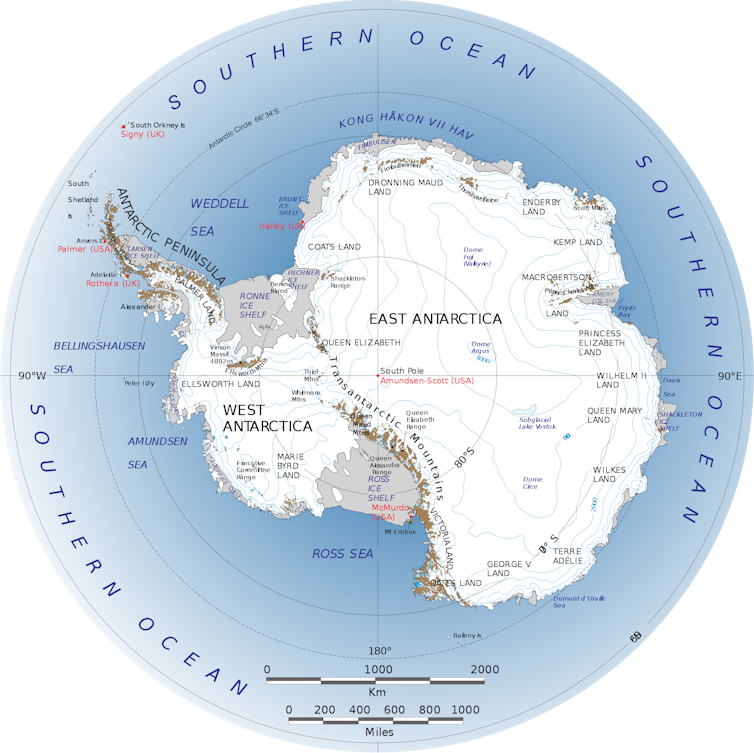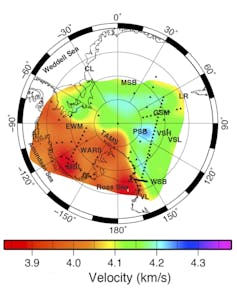
Working in West Antarctica is profoundly humbling. We scientists work from tiny field camps incongruously airdropped onto a vast plain of kilometers-thick glacial ice extending from horizon to horizon. It is initially difficult to conceive that this vast polar desert icescape could drastically change over the course of a human lifetime.
Yet, recent studies have revealed that ice loss is accelerating. In addition, floating ice shelves that help restrict Antarctic glaciers from flowing into the Southern Ocean are thinning and weakening.
In both cases the primary culprit is warming ocean currents that are melting the undersides of these vast glacial systems where they are afloat. Sea level rise from glacial melt in Antarctica, Greenland, and rapidly dwindling mountain glaciers, compounded by thermally expanding oceans, could disrupt the lives of hundreds of millions as soon as 2100.
In a rare bit of good news on Antarctica, our new study found that the bedrock underneath the West Antarctic ice sheet is lifting much faster than previously thought. This rebound effect – the land underneath the ice sheet uplifting as the ice melts – is a result of a newly recognized Earth structure, and can possibly slow melting.
The ice storehouse
The vast majority of Earth’s ice resides in two distinct Antarctic ice sheets that, together, sequester about 90 percent of Earth’s fresh water in approximately 26.5 million cubic kilometers of ice. Together, they reflect millions of years of snow accumulation and glacial flow. Their prosaic names, East and West, reflect their approximate hemispheric locations. Antarctica’s ice, if wholly melted, would raise average sea level by an apocalyptic 60 meters.

The gargantuan East Antarctic Ice Sheet is very thick (up to 4,800 meters, or nearly three miles), high, cold, and its base is overwhelmingly above sea level. The smaller West Antarctic Ice Sheet is thinner, warmer and, importantly, occupies a rough bowl-like topography, with its deepest interior points plunging to more than 2,800 meters, or 1.7 miles, below sea level.
Scientists recognized in the 1960s that this peculiar geography makes the West Antarctic Ice Sheet susceptible to runaway instability. Under warming ocean and atmospheric conditions, it could collapse and deliver its ice to the sea on a time scale of just centuries to millennia.
Melting of the entire West Antarctic Ice Sheet would transform nearly every coastline, and coastal habitation, on Earth by adding about three meters to average global sea level. The Antarctic ice sheet is also so vast that its gravity attracts an enormous body of the nearby ocean. Release of this bulge would raise sea level in parts of the distant Northern Hemisphere by up to an additional meter.
Glaciologists have noted that West Antarctic Ice Sheet collapse may have begun in recent decades. While interventions to lower greenhouse gas emissions still offer hope to limit global sea level rise from melting glaciers, emerging West Antarctic Ice Sheet instability has become gravely concerning.

Grounding Line animation (topography greatly exaggerated) (Credit: Valentina R. Barletta, CC-BY)
Stability of West Antarctic Ice Sheet depends critically on where it is floating and where it is in contact with seafloor bedrock or sediments. The demarcation between grounded and floating regions is called the grounding line – this is the point deep beneath the ice sheet where it no longer in contact with land but is floating in ocean waters instead.
If the ice sheet thins due to melting from below, it floats higher and its grounding line will move inland. In this manner, more and more ice goes afloat, ice is more easily transported to sea to melt and potentially runaway collapse ensues.
A rebounding Earth and a seismic CAT scan
Credit: ESA/Planetary Vision
However, as ice mass is lost, the Earth also uplifts via a process called glacial isostatic adjustment. This provides a feedback that can moderate the ice instability. It was believed that the process would take too long, several millennia, to have practical effects on present-day ice loss. More recently, though, it has been recognized that if bedrock uplift is rapid enough – on the scale of centuries – it could protect West Antarctic Ice Sheet from collapse, at least under moderate levels of climate change.
In our newly published paper, we and co-authors use data that we collected in West Antarctica to show that glacial isostatic adjustment is occurring much more rapidly than previously thought. Our imaging of the deep Earth using CAT scan-like seismic techniques also delineates a large region where the mantle (that is, 50 kilometers below the Earth’s crust) is unusually warm and relatively fluid. Together, these observations improve our understanding of how the solid Earth below West Antarctic Ice Sheet will respond to ice loss.

A useful analogy for glacial isostatic adjustment is that of a double-layer mattress. First, the surface immediately springs back when ice is removed (think of a spring mattress at the top of the system) in response to reduced weight.
Secondly, and critically, there is a delayed uplift caused by slow responsive flow in the viscous mantle. This process is analogous to a deeper “memory foam” mattress that “remembers” its past load while it creeps back to its unloaded shape. If the mantle is cold and dry, this delayed uplift occurs on time scales in excess of millennia – regions near Hudson Bay and in Northern Europe are uplifting today in a ghostly response to the 10,000-years-gone northern ice sheets of the last ice age. If the mantle is relatively warm and hydrated, its viscosity will be much less, and the response can occur over just decades to centuries.
Uplift promotes stability
Deploying high-precision GPS instruments on remote rock outcrops, we discovered that glacial isostatic adjustment uplift in West Antarctica is among the fastest ever measured for a glacial region (up to 41 milimeters/year), and we showed that this is attributable to underlying warm and low-viscosity mantle. Theoretical calculations indicate that this surprisingly rapid uplift can inhibit or slow inland grounding line retreat and thus will make the West Antarctic Ice Sheet more stable. We furthermore predict that this rate should accelerate in coming decades.
Should society succeed in limiting the greenhouse gas concentrations of the atmosphere, the newly recognized rapid glacial isostatic adjustment uplift may cause the West Antarctic Ice Sheet to slow down in its ice retreat and stabilize at a smaller volume.
If glacial losses elsewhere also abate, sea level might then level out after a rise of approximately one meter from today. However, if we do not succeed in limiting emissions and global warming, the uplift, even rapid, will be insufficient to stabilize the West Antarctic Ice Sheet grounding line and, ultimately, insufficient to stabilize the ice sheet.
Richard Aster receives funding from the National Science Foundation. He s affiliated with Colorado State University.
Valentina Roberta Barletta is affiliated with DTU Space, Denmark
This article was originally published on The Conversation. Read the original article.







